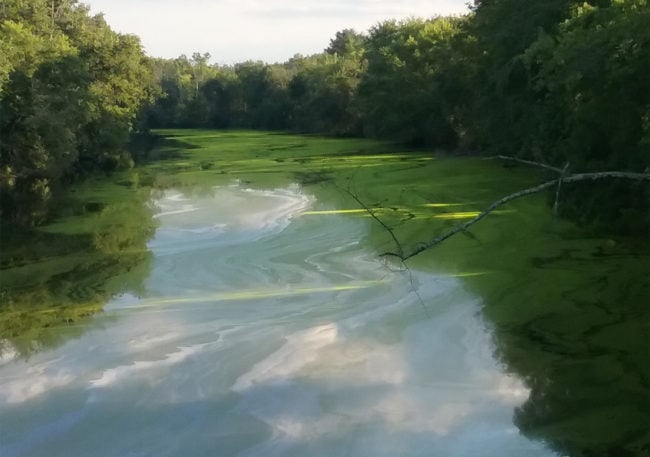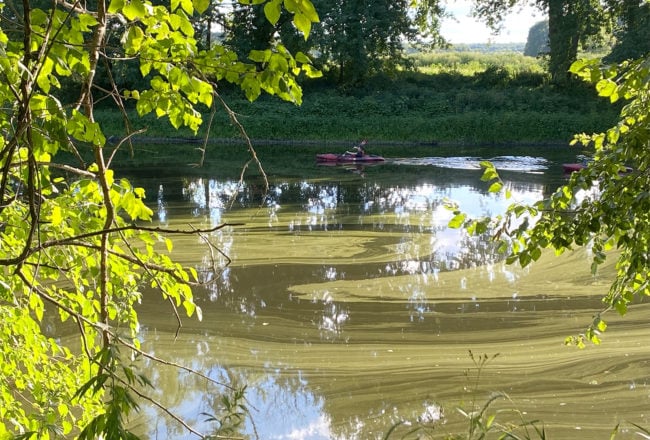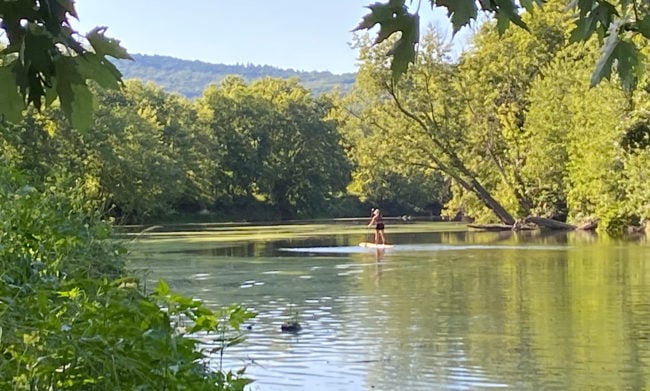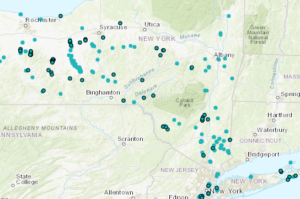As people flock to the water, parts of Wallkill and Rondout plagued by algal bloom

View more images on our Flickr site
9/30/2022 update:
This blog post has been updated and revised. No HABs have been observed since about September 2.
Learn more about the impacts of climate change on our watersheds Oct 24-26 at the annual Hudson River Watershed Alliance’s annual conference, “Climate Change Impacts on Water in the Hudson Valley.” On October 25, Dan Shapley will give a talk about climate extremes titled, “From drought to deluge: Water quality impacts and watershed community responses.” Register and get more information at hudsonwatershed.org.
In late Summer of 2022, a Harmful Algal Bloom (HAB) overtook parts of the Wallkill River and Rondout Creek, putting recreational users at potential risk from toxins produced by the algae. The Wallkill and Rondout combine to form the largest tributary to the tidal portion of the Hudson River.

A Harmful Algal Bloom on the Wallkill River, as seen from the Wallkill Valley Rail Trail trestle north of New Paltz on August 11, 2022. Photo by John Gotto.
The HAB was first reported to Riverkeeper by New Paltz Kayaking, a local business that helps people enjoy the joys of kayaking on the Wallkill. It and A Day Away Kayak Rentals on the Rondout helped to document the bloom. Their businesses were also affected by it, as they had to turn customers away some days. Farmers, too, and other recreational users of the water, faced risks or questions as they used the water. Signs were posted by the NYS Department of Environmental Conservation and local municipalities warning people of risks they might encounter from exposure to the HAB.
Riverkeeper engaged a number of individuals and organizations to help document, study and respond to the algal bloom, including Hudson River Watershed Alliance, Cary Institute, Wallkill River Watershed Alliance, Bard College and the NYS Department of Environmental Conservation (DEC). The Hudson River Watershed Alliance made the first public warning about the HAB in a Facebook post that reached tens of thousands of people. Lab tests confirmed the presence of cyanobacteria.
The observed location and extent of the algal bloom has shifted between its first observed appearance on August 11 and its last observed appearance around September 2. The bloom was observed primarily at points along a 15-mile stretch from the vicinity of the River to Ridge trail and Gardens for Nutrition in New Paltz, downstream (north) to the tidal Rondout Creek at Eddyville, just west of Kingston. This is believed to be the most significant HAB observation for the estuary, where only diffuse cyanobacteria blooms have been observed in the past, including by Riverkeeper in 2018. Scientists have warned that changing climate conditions could put the Hudson estuary at risk for algal blooms that have previously been buffered by tidal mixing and turbidity. (See this Cary Institute video, “Science for the Future of the Hudson River” at minutes 32 and 55 for one of those warnings.) The bloom was visible at all locations throughout this stretch on all days or all times, and the extent has shifted from day to day and even hour to hour.
Every time observers visited the river to document the location of the HAB, they also observed extensive public use of the water. Activities observed include kayaking, stand-up paddle boarding and even one person on a pool float, in addition to angling and dogs swimming. Our rivers should be safe for these uses. It’s a shame that in the height of summer, some of our most cherished waterways present a risk instead of a respite.

A kayaker in a stretch of the Wallkill River affected by a Harmful Algal Bloom near the Gardens for Nutrition in New Paltz on August 14, 2022. Photo by Emily Vail / Hudson RIver Watershed Alliance.
Called Harmful Algal Blooms, HABs are actually caused by cyanobacteria (not algae). Algae is a natural part of freshwater ecosystems, and most algae is not harmful. One of the oldest lifeforms on Earth, cyanobacteria can overtake a waterbody, creating bright green mats. HABs vary in appearance from scattered green dots in the water, to long, linear green streaks, pea soup, or spilled green paint, to blue-green or white coloration.
As the cyanobacteria proliferate, they can produce toxins that put recreational users, drinking water supplies, pets and livestock at risk. Dogs are among the most at-risk groups, as they not only can ingest water while swimming, but also while grooming after a swim. The most common risk to humans is skin irritation, but serious neurological damage can also result from exposure to some strains.

A stand-up paddleboarder navigates a stretch of the Wallkill River affected by a Harmful Algal Bloom near the River2Ridge trailhead in New Paltz on August 12, 2022. Photo by Emily Vail / Hudson River Watershed Alliance.
The Wallkill River has suffered from harmful algal blooms in the past, most notably in 2016, when 30 miles of the river was affected for about 60 days, from mid-August into October. Like the 2022 bloom, the areas of the river affected by the bloom shifted from week to week, day to day and hour to hour. The 2022 bloom was less extensive in area affected and duration, though it reached farther downstream than the 2016 bloom.
The 2016 algal bloom catalyzed a DEC commitment to putting the Wallkill River on a “pollution diet” that will ultimately reduce the overload of phosphorus, a nutrient that fuels HABs. This work has included a multi-year study of water quality throughout the Wallkill River and its tributaries to better understand sources of pollution. The multi-year “pollution diet” effort will ultimately prioritize the most efficient actions to reduce nutrient loads in the river, and use the authority of the Clean Water Act to target those pollution sources. Major sources of nutrients in the Wallkill include treated sewage and farm fertilizers, and much of the Wallkill River Watershed has concentrations of key nutrients greater than 90% of waterbodies in our region (see video at minute 54:48), according to DEC and Riverkeeper data analyzed by DEC. These excess nutrients have also contributed to a measurable decline in ecological health in the river’s aquatic life, as described by DEC in a presentation at a Wallkill River Watershed Alliance Summit in 2019 (see video at minute 59:25). Since 2016, there has also been tens of millions of dollars invested in wastewater treatment improvements in the Wallkill River Watershed, thanks to the Clean Water Infrastructure Act, and a $182,000 investment in helping farms reduce runoff in the Wallkill watershed. The Wallkill River Watershed Alliance has also supported communities in complying with stormwater regulations, while engaging people in river recreation, tree planting, trash cleanups and other activities.
Reducing the underlying pollution burden is particularly important to protect the river and its enthusiasts in the face of climate change.
Due to greenhouse gas pollution primarily from burning fossil fuels, we should expect more extreme hot and dry summers. This kind of climate extreme sets the stage for algal blooms by making water warm up and move slowly – conditions that are also exacerbated by multiple dams on the Wallkill River.
The alterations we’ve made to the climate and river have turned a source of summer joy into a bright green toxic risk. Reducing pollution can act as a bulwark against climate change, ensuring that the ecosystem of which we are a part provides safe water for recreation. The Harmful Algal Bloom this summer should be a bright green call to action to expedite this work.

Kayakers enter the Rondout Creek affected by a Harmful Algal Bloom at DEC’s Creek Locks Road access site on August 15, 2022. Laboratory analysis confirmed that microcystis, cyanobacteria that can produce toxins, were present. Photo by Dan Shapley / Riverkeeper.
 If you see a Harmful Algal Bloom, report it using the form on the DEC’s Harmful Algal Blooms: Know It! Avoid It! Report It! Page. See where HABs have already been reported with this DEC HABs map, which is updated regularly.
If you see a Harmful Algal Bloom, report it using the form on the DEC’s Harmful Algal Blooms: Know It! Avoid It! Report It! Page. See where HABs have already been reported with this DEC HABs map, which is updated regularly.
